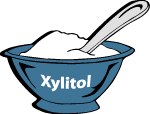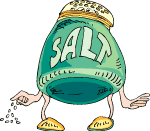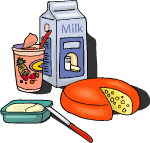 Steven H. Horne, RH (AHG)
Steven H. Horne, RH (AHG)
In our culture, white is typically thought of as a color denoting purity and goodness, but in nutrition, more often than not, white is “evil.” That’s because whole foods are typically loaded with color, which is an indication of the wonderful variety of nutritional compounds they contain. When food is refined and processed, it usually winds up becoming an isolated “white” substance.
So, the four white horses I’m about to talk about are the four major groups of processed food that are destroying people’s health. To dramatize the harmful impact of these processed foods, I’ve borrowed a metaphor from the Book of Revelation in the Bible. Revelation is an apocalypse or “vision” of the end times and contains a reference to four “horses” that are supposed to bring destruction on mankind. Traditionally, these four horses (white, red, black and pale) are thought to represent conquest, war, famine and death.
Now, don’t worry, I’m not preaching religion to you. I’m just trying to stress how many millions of people in the world are suffering and dying because of these harmful influences. With 80% of our population dying of degenerative diseases that are directly linked to the consumption of these processed foods, they are truly causing an apocalyptic destruction of our health.
So, what are these “four white horses of the nutritional apocalypse?” They are (in order of the severity of their destructive influence on our health):
- Refined carbohydrates (table sugar, high fructose corn syrup, white flour, polished rice and other refined carbohydrates);
- Processed vegetable oils (partially hydrogenated oils, margarine, shortening and trans-fatty acids);
- Refined salt (and other food additives) and
- Commercial dairy foods.
If you take a look at the top ten most popular foods for most Americans—soft drinks, pastries, hamburgers, pizza, chips, rice, bread, cheese, beer and French fries—you’ll see that nearly all of them contain these four nutritional evil-doers.
Besides being the primary culprits in the major killers—heart disease, cancer and diabetes—these processed foods also contribute to obesity, tooth decay, osteoporosis, arthritis and a host of other ailments that destroy the quality of life for millions of people.
It’s time to expose these four destroyers of mankind, clothed in “innocent” white, for what they really are. It’s not too late to defeat them, at least in our own lives, and perhaps we can even help others to join in the battle. Let’s get to know our enemy and what we can do to win the battle for our good health.
The First White Horse of the Nutritional Apocalypse
Refined Carbohydrates
The average American consumes between 125 to 175 pounds of refined sugar per year. That’s about 1/3 to 1/2 pound per day! Most of this is in the form of table sugar (sucrose) or high fructose corn syrup. Both products are a mixture of glucose (blood sugar) and fructose and both have the same health-destroying effects.
Grains contain a lot of starch, which is broken down into sugar by the digestive tract. Refined grains convert rapidly into simple sugars and have the same problems as refined sugars.
Refined carbohydrates damage our health in three basic ways. First, they deplete the body’s nutritional stores. Second, they adversely affect our brain and nervous system, making it difficult to think straight. Finally, these simple carbohydrates spike insulin production, which contributes to chronic inflammation and obesity. Let’s look at each of these factors more closely.
Refined Carbohydrates Deplete Nutrient Reserves
Sugar has to be metabolized in our cells in order to be converted into fuel. These metabolic processes require various nutrients to work properly, including B-vitamins, vitamin C and many minerals such as chromium, vanadium and magnesium.
In whole foods these nutrients are present along with the sugar, so the body is able to properly control and regulate sugar metabolism. When we eat refined sugar, however, the body has to obtain these nutrients from other sources, including borrowing from your nutritional reserves if it has to.
This is the primary reason why sugar rots your teeth. While it is true that sugar feeds the bacteria that cause tooth decay, this isn’t enough to rot your teeth. Workers in the sugar cane fields ate sugar cane, but this did not rot their teeth.
The real reason sugar causes tooth decay is because sugar depletes your mineral reserves. This not only weakens your teeth, it weakens your bones. So, consumption of refined sugar is linked with more than tooth decay; it is also a causal factor in arthritis and osteoporosis.
Refined Carbohydrates Mess-Up Your Mind
Because refined carbohydrates rob reserves of B-vitamins, they also adversely affect your nervous system. B-vitamins are needed both in cellular energy production and in the production of neurotransmitters. So, they are vital to brain function.
Natural carbohydrates contain B-vitamins. The molasses drawn off of the sugar during processing is loaded with them. Whole grains are also good sources of B-vitamins, which are lacking in white flour and polished rice. Sure, some token B-vitamins are added back in to “enrich the flour,” but that’s like a thief taking $50 from you and handing you $2 telling you he’s “enriching” you.
But the depletion of B-vitamins and other nutrients isn’t the only reason sugar adversely affects your brain. It’s also because the brain is the biggest consumer of sugar in the body and the level of sugar in the brain is directly regulated by the level of sugar in the blood. Too much sugar and the brain is overstimulated, causing hyperactivity, irritability and nervousness.
Too little sugar and the brain doesn’t function properly. When there isn’t enough sugar to keep the entire brain functioning properly, the brain shunts energy away from the cerebral cortex (where we have conscious control of ourselves) and into the lower brain centers, which keep us alive. This makes us act on animal instinct, rather than rational thought. This results in mental confusion, irritability or lethargy, irrational thinking and moodiness.
Refined sugar puts the sugar level in the blood on a roller coaster ride, which puts the brain (including your mood and your ability to think straight) on a roller coaster ride, too. This is why refined sugar consumption has been linked to hyperactivity, ADHD, anxiety, irritability, reduced performance in school, juvenile delinquency, mental illnesses like schizophrenia and even increased criminal behavior.
Refined Carbohydrates Spike Insulin Production
This brings us to the final reason why sugar harms our health. The job of the pancreas is to keep blood sugar levels stable so the brain has the right amount of sugar to function properly.
When there is too much sugar in the blood (hyperglycemia), the pancreas secretes insulin to drive this sugar into storage. When the blood sugar level drops too low (hypoglycemia) the pancreas secretes glucagon to bring sugar out of storage.
 Insulin depresses glucagon production and glucagon depresses insulin production. This relationship, which is much like a hormonal teeter-totter, is called a hormonal axis.
Insulin depresses glucagon production and glucagon depresses insulin production. This relationship, which is much like a hormonal teeter-totter, is called a hormonal axis.
When large quantities of simple carbohydrates enter the blood stream, the pancreas secretes insulin to try to protect the brain from the excess sugar. This depresses glucagon production, so when the sugar in the blood has been used up, the body has a hard time mobilizing sugar from storage. The result is hypoglycemia, low blood sugar.
This causes cravings for sugar, which jacks the sugar level up again. This is why blood sugar starts taking a roller coaster ride, taking your mood along with it.
These high insulin levels cause fat stores to increase as the body tries to find ways to store the sugar. The hypoglycemic reactions from this can also cause stress on the adrenals, especially when someone is using caffeine to stimulate them. Stress hormones like cortisol are used to try to bring blood sugar levels up again. This contributes to adrenal fatigue.
High insulin levels also depress the production of prostaglandins that control inflammation. As the adrenals also become exhausted from the sugar and caffeine consumption, they also lose their ability to control inflammation. Chronic inflammation sets in, which leads to heart disease, cancer and inflammation in the brain which contributes to the destruction of brain cells.
Defeating the White Horse of Refined Carbohydrates
Frankly, I could go on and on, spending the rest of this article just documenting how bad this “white” stuff is for you, but I’ve still got three “horses” to go, so we need to move on to talking about how we can defeat this white Trojan horse that sneaks its way into our diets at every turn. So, here’s a three step battle plan for overcoming this destructive influence on our health.
1. Think Substitution Instead of Avoidance
You’ll never kick the sugar and white carbohydrate habit by trying to avoid all sweets and starchy foods. Forget it. We need carbohydrates. They give us energy, and we crave sweets because our senses were designed to look for natural foods that contain the carbohydrates we need.
 So, instead of just trying to avoid the white guys, start consciously seeking out the brown guys. Yep, when it comes to carbohydrates, brown is beautiful.
So, instead of just trying to avoid the white guys, start consciously seeking out the brown guys. Yep, when it comes to carbohydrates, brown is beautiful.
This means we need to start using whole natural sugars such as freeze-dried sugar cane juice, genuine raw sugar, raw honey, agave nectar, brown rice syrup and maple syrup. We also need to use whole grains.
These brown “good guys” are all natural sources of sugar that also contain other nutrients which help you utilize the carbohydrates properly. In my experience this results in a greater sense of satisfaction, which automatically makes you eat less of the sweet stuff. Also, once your body is used to getting whole natural sugars, it becomes easier to avoid the refined stuff because you start noticing how bad it actually makes you feel.
Another strategy to defeating the white carbohydrates is to use xylitol. This naturally-occurring “sugar-alcohol” is another great alternative to refined sugar. Although it is a refined product itself, it has some very positive benefits refined sugar doesn’t. For one, it not only won’t rot your teeth, it actually helps re-mineralize bones and teeth.
Xylitol is both antifungal and antibacterial, so it fights gum disease, tooth decay, sinus, strep and yeast infections. It has less calories than sugar and doesn’t spike blood sugar levels.
However, I think one of the best things about xylitol is that it actually helps reduce cravings for sugar. So, if you use it, you’ll get your sweet “fix” and a cure for the addiction at the same time.
The only problem with xylitol is that some people have a hard time getting their digestive tract to adjust to it. That is, it can cause loose stools in some people, probably because it alters the balance of their friendly flora. So, start slowly with it and give yourself time to adjust.
Another great thing about xylitol is that it has the same sweetness as sugar so it can be substituted one to one for sugar in recipes. This makes it a good option for baking.
Xylitol will not work for candies or bread however. This is because it won’t crystallize and it kills, rather than feeds, the yeast in the bread dough.
Another option for a natural sugar substitute is stevia. Stevia contains glycosides that are 50 times sweeter than sugar, so an extract of stevia also makes a good natural sweetener. Because it balances blood sugar levels, it also takes away carbohydrate cravings.
I like stevia best for sweetening my herbal tea or herbal “coffee.” It has a slight aftertaste and is hard to use in baking because you have to really make major adjustments to recipes.
Finally, don’t overlook the carbohydrates that your body is really looking for. Eat fresh fruits and vegetables. They’ll not only provide you with natural sugars and the nutrients your body needs to process them, they’re also loaded with antioxidants that protect you against degenerative disease.
2. Start the Day with Fat and Protein at Breakfast
The second strategy for defeating the white horse of refined carbohydrates is to eat a good breakfast. Your blood sugar level is going to be a little low in the morning because you’ve been fasting all night. That’s why we call the first meal of the day, break fast.
 If you break your fast by eating simple carbohydrates, such as pastry, donuts, toast and breakfast cereals (even whole grain varieties), you trigger an insulin reaction that starts you on the blood sugar roller coaster ride all day. Conversely, when you break your fast with high protein foods, you stimulate the release of glucagon, which mobilizes stored reserves of sugar and lowers insulin production.
If you break your fast by eating simple carbohydrates, such as pastry, donuts, toast and breakfast cereals (even whole grain varieties), you trigger an insulin reaction that starts you on the blood sugar roller coaster ride all day. Conversely, when you break your fast with high protein foods, you stimulate the release of glucagon, which mobilizes stored reserves of sugar and lowers insulin production.
So, eating protein for breakfast, not only stabilizes your blood sugar level, it also helps you burn fat and lose weight. Eating some good quality fat for breakfast also helps this process.
Since hydrochloric acid production is highest in the morning, and lowest in the evening, it makes sense that we should eat our heavier proteins early in the day rather than later. I find that I digest high protein foods better in the morning, but when I eat meat late at night, I don’t do so well.
Organic eggs, meat, shakes made with protein powders, plain whole milk yoghurt, organic cheese and believe it or not, beans, all make great breakfast foods. Organic eggs, avocados, organic cheese and whole milk yoghurt, coconut oil and organic meat will also supply good fats to further stabilize your blood sugar.
If you crave carbohydrates and sugar, avoid eating fruit, fruit juice or even whole grain cereal at breakfast until your metabolism stabilizes. Once you don’t crave these simple sugars anymore, it’s good to eat some of these foods for breakfast, too.
3. Take Supplements to Balance Blood Sugar
The final step in my three part program for defeating the white horse of simple carbohydrates is to use supplements that help to balance your blood sugar. An old standby is HY-A, a Paavo Airola formula that also aids digestion. Take two capsules, three times daily with meals.
Licorice Root is another great herb to stabilize blood sugar levels. I’ve used it for years with great results in both children and adults. For adults, the dose is two capsules at breakfast, two at lunch and two more in the mid-afternoon.
Super Algae is another good supplement for hypoglycemia and sugar cravings. Its high content of amino acids works to stabilize both energy and blood sugar. Take two at breakfast, two at lunch and two more anytime you feel an energy slump. It can be used with Licorice Root, which makes it even more effective.
Finally, Glyco Essentials contains eight essential sugars that are used in cellular communication, immune functions and other body processes. Ingesting this complex of natural sugars can also reduce sugar cravings.
Other supplements that may help with sugar cravings include Target Endurance (which is especially helpful for people who crave sugar and caffeine), NutriCalm, B-Complex vitamins and chromium. The B-vitamins and GTF chromium help the body utilize sugar properly.
The Second White Horse of the Nutritional Apocalypse
Processed Oils
Right behind white carbohydrates in the battle to destroy our health is processed oils. These “white” fats are a major contributing factor to heart disease, chronic inflammation, dementia and other diseases involving nervous system problems and diabetes.
 Like white flour and sugar, processed vegetable oils have been stripped of most of their nutritional value. Natural oils contain vitamins, minerals and other nutritional factors that help the body process the fat. The process of extracting the oils destroys this nutritive value.
Like white flour and sugar, processed vegetable oils have been stripped of most of their nutritional value. Natural oils contain vitamins, minerals and other nutritional factors that help the body process the fat. The process of extracting the oils destroys this nutritive value.
Processed oils are usually extracted using heat, then degummed (a process which removes phospholipids like lecithin and minerals like iron, copper, calcium and magnesium). They are usually partially hydrogenated, a process which involves adding hydrogen to the oil in the presence of nickel.
Like the process of making refined sugar and white flour, the final stage of making “white” oil is to bleach it. Sodium hydroxide (found in Drano®) is added to remove free fatty acids and the bleaching process also removes beta-carotene and the essential oils that give natural vegetable oils an aroma.
Processed oils are often heated to high temperatures, a process which causes the formation of trans-fats. Heating oils to just 300 degrees starts the process of causing fatty acids to become mutagenic (cancer causing). Trans-fatty acids start forming at 320 degrees and at 392 degrees significant quantities of trans-fats are formed. The more you reuse an oil for frying, the more trans-fats you’ll create.
Like the plan for defeating white carbohydrates, the primary way to defeat the white fats is by substituting them for good fats. Again, we need fats, just like we need carbohydrates, so the best way to avoid bad fats is by crowding them out of our diet with good ones.
Deep ocean fish (mackerel, sardines, anchovies, albacore tuna, etc.) and fish oils (cod liver oil and Omega-3 supplements) are a great way to get good fats. Avocados, nuts (especially walnuts and Brazil nuts) and seeds (like flax, chia, hemp, pumpkin, sesame) are also good sources of natural, healthy fat.
For frying, use coconut oil. This medium-chain saturated fat is very heat stable and is also good for you. You can even eat some straight from the jar. Another good oil for frying is safflower oil or a mixture of safflower and olive oil.
Finally, organic butter from grass fed cows is better than margarine, which is basically shortening with artificial flavor and color. I make a soft spread butter by mixing one pound (2 cups) of butter which has softened to room temperature with one cup of flax seed oil using a hand blender. You can also make this with hemp seed oil (which makes a slightly green butter) or cold-pressed extra virgin olive oil.
The resulting spread will stay soft in the fridge. It is more nutritious than plain butter and has a nice “nutty” flavor which I actually prefer to plain butter.
It may also be helpful to take supplements to help you break down and process fats properly. Hi-Lipase is a good choice, especially if you have trouble digesting fats or have had your gall bladder removed. I also find fringetree bark to be a good single herb for stimulating bile flow from the gallbladder to help digest fats.
SF and Chickweed help the liver metabolize fats properly. They are especially helpful if you have fatty congestion in your liver.
 The Third White Horse of the Nutritional Apocalypse
The Third White Horse of the Nutritional Apocalypse
Refined Salt and Food Additives
Natural salt contains traces of iodine and other minerals which give the salt a little bit of color. But, like so many other foods, we have to bleach salt, too, to remove these traces of other nutrients. Refined “white” salt also contains up to 15% additives to prevent caking, etc.
For years, I thought salt was bad, period, and just avoided it. I felt much better when I did. However, like our desire for carbohydrates and fats, there is a good reason we crave salt. Our body needs it.
But, just as with oil and carbohydrates, our body needs natural salt that has not been rendered white by stripping it of much of its nutritional value. So again, the best way to defeat this white horse is to use a healthier alternative.
NSP’s Sea Salt is the same as Real Salt, a light pink salt from an old salt dome in Redmond, Utah. I’ve been using it for years and it’s wonderful for your health. You’ll actually find your body craves this good salt, and will start to shun the refined salt.
I also use the light grey Celtic salt. It’s a wonderful salt, too, and just tasting a little of it, you can feel the good energy it has. Both of these salts are natural sources of iodine, an important mineral that is deficient in many people’s diets.
Recently, more natural salts have found their way into health food stores and specialty grocery stores. Each of these salts has unique flavors and properties and I’m looking forward to trying others. (It’s the gourmet in me. I enjoy foods with depth of flavor.)
Oh, and while we’re switching out the refined salt, it’s a good idea to avoid food additives in general. They may not all be white, but they are certainly henchmen of this third white horse of the nutritional apocalypse.
This includes preservatives, artificial flavors, artificial sweeteners and most food colorings. These chemicals burden the liver because they have to be eliminated from the system. The more chemicals you can avoid, the better off your liver and immune system will be.
The Fourth White Horse of the Nutritional Apocalypse
Commercial Dairy Products
Our fourth, and last, bringer of disease and death in the American diet is refined and processed milk (and other commercial dairy products). This symbol of innocence and goodness (as in “mother’s milk” and the “milk of human kindness”) has also been perverted through modern processing.
 Raw milk from grass fed cows is good stuff. Years ago I thought milk, like salt, was simply bad for you. I avoided it because of my chronic sinus problems and found that I was a lot healthier for it.
Raw milk from grass fed cows is good stuff. Years ago I thought milk, like salt, was simply bad for you. I avoided it because of my chronic sinus problems and found that I was a lot healthier for it.
Then, I read a great book called The Milk of Human Kindness is Not Pasteurized by William Campbell Douglas. You can still find it on the internet. After reading this book I realized that milk could be good food when it’s actually natural.
There are many ways this once wholesome food has been dramatically altered in our modern world. For starters, cows aren’t fed on grass, they’re fed artificial feed, hormones and antibiotics in big commercial dairies. These substances make their way into the milk and concentrate in the fat.
Then, the milk is cooked, which destroys much of its nutritional value. Cooking milk is actually used to cover for unsanitary conditions in modern dairies. It is entirely possible to produce very clean, disease-free milk in today’s world.
In natural milk, the cream floats to the surface, but when milk is homogenized, the fat molecules are broken into smaller particles to make them stay in suspension. There is some evidence that this process causes oxidation of the fat, which contributes to heart disease.
Furthermore, the fat in commercial milk is where the fat-soluble pesticide residues, hormones and other pollutants ingested by the cows, accumulate. Organic milk avoids this concentration of chemicals in the fat, but organic milk, is usually ultra-pasteurized, which really destroys milk’s nutritional value.
The bottom line is that finding quality dairy foods in today’s world is hard. It’s easy to locate the healthy substitutes four our first three white horses, but it’s hard to find raw, organic milk.
When my kids were younger, we were fortunate enough at the time to have a raw milk dairy not too far from where we lived. We would buy raw milk, cheese, cream and other dairy foods, so my children were fortunate enough to have some of this wholesome food growing up. Unfortunately, this dairy has closed down.
There is a raw milk dairy about 50 miles from where I currently live. It is not organic, but I do travel over there once in a while to get some raw milk, raw milk cheese and other dairy products. I like to make raw milk kiefer, which is wonderful stuff for your digestive tract.
All the local organic dairy products are ultra-pasteurized so I tend to avoid them. I use a small amount of soy milk, but this isn’t a very natural food, either.
When I go to the Whole Foods store in Las Vegas, I purchase the pasteurized organic dairy products available there. I buy organic, whole milk yoghurt (with cream on top) and organic raw milk cheeses as these fermented dairy products are easier to digest after they’ve been “cooked.”
Of course, not everyone has the metabolism to utilize milk properly (70% of the people in the world are lactose intolerant), but this is easily overcome by using beneficial bacteria to turn milk into yoghurt and cheese. By pre-digesting the milk, the bacteria make it easier to digest and less likely to cause allergic reactions.
Of course, there is another option—goats milk, which is closer to human milk than cows milk. I personally love cheese made from goats milk and you can even get goats milk yoghurt.
It’s plain to see that these four white horses of the nutritional apocalypse are wide-spread in their health destroying influence. Still, it is possible to defeat them, not by avoiding them, but by deliberating concentrating on seeking out the natural products the body really needs. So, when you think nutrition, remember that white is usually evil and color is good.

